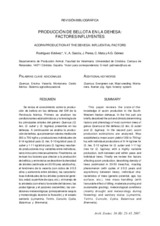Mostrar el registro sencillo del ítem
Producción de bellota en la dehesa: factores influyentes
| dc.contributor.author | Gómez-Castro, A.G. | es_ES |
| dc.contributor.author | Rodríguez-Estévez, V. | es_ES |
| dc.contributor.author | Perea Muñoz, José Manuel | es_ES |
| dc.contributor.author | García Martínez, Antón Rafael | es_ES |
| dc.contributor.author | Mata, C. | es_ES |
| dc.date.accessioned | 2010-04-08T11:15:32Z | |
| dc.date.available | 2010-04-08T11:15:32Z | |
| dc.date.issued | 2007 | |
| dc.identifier.issn | 1885-4494 | |
| dc.identifier.uri | http://hdl.handle.net/10396/2877 | |
| dc.description.abstract | This paper reviews the state-of-the-knowledge of acorn production in the South-Western Iberian dehesas. In the first part are briefly described the soil and climatic determining factors and phenology of most common trees of genus Quercus at the dehesa (Q. ilex, Q. suber and Q. faginea). In the second part, acorn production estimations are analyzed. Was established a mean acorn yield of 300 to 700 kg/ha; with individual productions of 8-14 kg/tree for Q. ilex, 5-10 kg/tree for Q. suber and 1-11 kg/tree for Q. faginea; with a highly variable production, both between and within years and individual trees. Finally we review the factors affecting acorn production, describing density of trees (estimated in 20-50 trees/ha), masting phenomenon (with cycles of 2-5,5 years and asynchrony between trees), individual cha-racteristics of trees (genetic potential, age, top surface, etc.), tree mass handling (with favourable effect of tilling, moderate pruning and sustainable grazing), meteorological conditions (mainly drought and meteorology during flowering) and sanitary status (Lymantria, Tortrix, Curculio, Cydia, Balaninus and Brenneria). | en |
| dc.description.abstract | Se revisa el conocimiento sobre la producción de bellota en las dehesas del SW de la Península Ibérica. Primero se analizan los condicionantes edafoclimáticos y la fenología de los principales árboles del género Quercus (Q. ilex, Q. suber y Q. faginea) presentes en las dehesas. A continuación se analiza la producción de bellota, que presentan valores medios de 300 a 700 kg/ha y producciones individuales de 8-14 kg/árbol para Q. ilex, 5-10 kg/árbol para Q. suber y 1-11 kg/árbol para Q. faginea; resultando producciones muy variables entre individuos, tanto intra como interanualmente. Finalmente, se revisan los factores que afectan a la producción de bellota; y entre éstos se describen la densidad de árboles (estimada en 20-50 pies adultos/ha), el fenómeno de la vecería (con ciclos de 2-5,5 años y asincronía entre árboles), las características individuales de los árboles (potencial genético, edad, superficie de copa, etc.), el manejo de la arboleda (con efecto favorable del laboreo, las podas ligeras y el pastoreo sostenible), las condiciones meteorológicas (principalmente sequía y meteorología durante la floración) y el estado sanitario (Lymantria, Tortrix, Curculio, Cydia, Balaninus y Brenneria). | es_ES |
| dc.format.mimetype | application/pdf | es_ES |
| dc.language.iso | spa | es_ES |
| dc.publisher | Universidad de Córdoba, Servicio de Publicaciones | es_ES |
| dc.rights | https://creativecommons.org/licenses/by-nc-nd/4.0/ | es_ES |
| dc.source | Archivos de zootecnia 56 (Revisiones), 25-43 (2007) | es_ES |
| dc.subject | Vecería | es_ES |
| dc.subject | Sistema agrosilvopastoral | es_ES |
| dc.subject | Quercus | es_ES |
| dc.subject | Montanera | es_ES |
| dc.subject | Encina | es_ES |
| dc.subject | Cerdo ibérico | es_ES |
| dc.title | Producción de bellota en la dehesa: factores influyentes | es_ES |
| dc.title.alternative | Acorn production at the dehesa: influential factors | en |
| dc.type | info:eu-repo/semantics/article | es_ES |
| dc.relation.publisherversion | http://www.uco.es/organiza/servicios/publica/az/az.htm | es_ES |
| dc.rights.accessRights | info:eu-repo/semantics/openAccess | es_ES |

